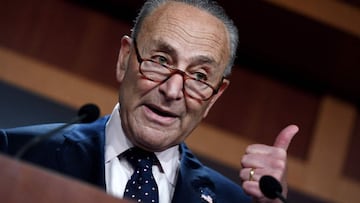Until when has the US Senate extended the debt ceiling and why was it extended temporarily?
A Senate vote on Thursday evening gave the Democrats an eight-week debt ceiling extension, but some Republicans believe their leadership folded too easily.


The Senate has passed the legislation required to temporarily raise the United States’ debt ceiling, heading off the threat of a first ever federal default in the coming weeks. The Democrats were joined by 11 Republicans who allowed the bill to pass; it still needs approval in the House before it can be signed into law.
The legislation would see the debt ceiling temporarily raised by $480 billion until 3 December. Although there was a strand of bipartisan sentiment in the Upper House the Republicans remained unwilling to support a permanent increase to the debt ceiling.
Read more
- Senate approves $480 billion temporary debt increase
- Congress faces three major economic deadlines
- Why is Washington DC the capital of the US?
Senate agrees on short-term solution
The 3 December extension gives lawmakers an extra eight weeks to look for a permanent remedy, extending the 18 October cut-off that had been estimated by the Treasury Department. However those deadlines are little more than predictions and it can be difficult to estimate the expenditure of the entire federal government over time.
Shai Akabas, director of economic policy at the Bipartisan Policy Center, said: “There is no way to predict with any precision exactly how much you would need to increase the debt limit by to get to a certain date.”
U.S. Senate votes 50-48 to raise the debt limit by $480 billion through December 3.
— CSPAN (@cspan) October 8, 2021
The legislation now heads to the House.https://t.co/6j73MDlLns pic.twitter.com/Ehgg2ahdLB
This means that the debt ceiling could actually be reached before or after the 3 December date, adding an extra level of uncertainty. With that in mind, Democrats are eager to find a more permanent solution to the debt ceiling issue.
Senate Majority Leader Chuck Schumer said in the immediate aftermath of Thursday’s vote: “What is needed now is a long-term solution so we don’t go through this risky drama every few months.”
How did the debt ceiling extension pass the Senate?
In the past 48 hours leading up to the Senate vote, negotiations changed dramatically with a number of key Republicans signalling that they would be willing to work with Democrats to secure a debt ceiling increase. It was led by Senate Minority Leader Mitch McConnell who proposed a new deal which required at least ten GOP senators to vote to block the use of the filibuster and allow the Democrats to initiate the temporary increase.
Related stories
McConnell managed to convince another ten GOP lawmakers to follow his lead, giving a 61-vote supermajority in favour of bypassing the filibuster. However his tactic has been very controversial within his own party, and many senators have hinted that they are concerned that McConnell folded too easily in the face of pressure from the Democrats.
Sen. @tedcruz on Democrats' ability to raise the debt ceiling: "They could've done it with only Democratic votes and there was not a single thing Republicans could've done to stop them. They know that. They don't dispute that. So why are we facing a crisis?" pic.twitter.com/naRTK6pCkD
— The Hill (@thehill) October 8, 2021
GOP Sen. Ted Cruz told reporters on Thursday: "Two days ago Republicans were unified. We were all on the same page. ... Schumer was on the verge of surrendering. And, unfortunately, the deal that was put on the table was a lifeline for Schumer, and I disagree with that decision."
